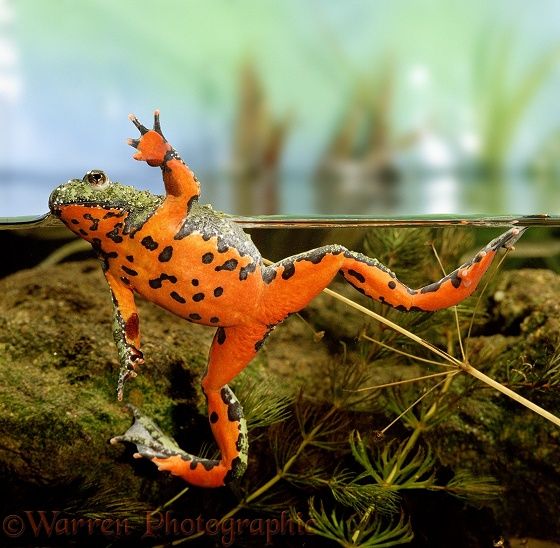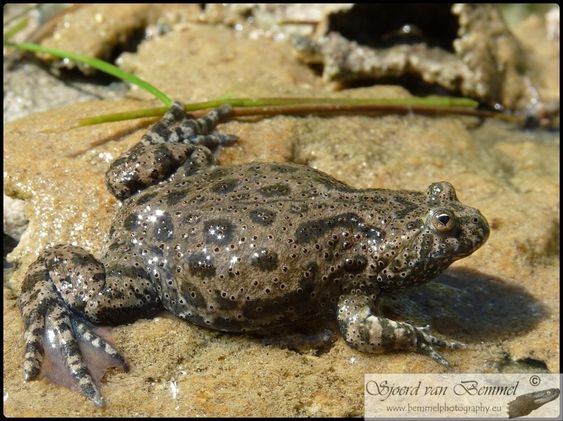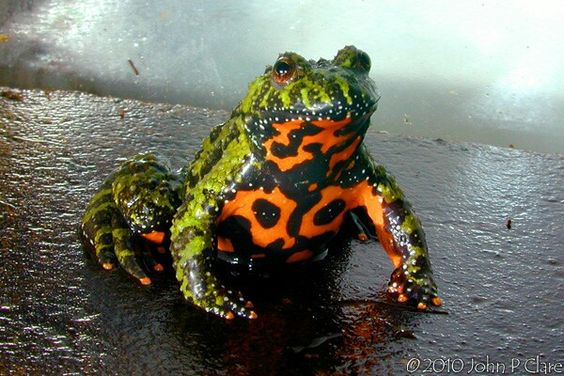Fire-bellied Toads are colorful animals belonging to the Amphibian family. They are termed as fascinating pets because it is very relishing watching them. They don’t want much care and upkeep and can live in small groups.
However, they secret a toxin from the skin which helps them in case of any danger and stress. This toxin is basically a defense mechanism not dangerous for humans but can cause redness and irritation on the skin.
Here is a complete care guide for beginners, containing all the necessary information about the Fire-bellied Toad.
Distribution
Fire-bellied Toads (Bombina bombina) are colorful amphibians belonging to the Bombinatoridae family. They are actually frogs in real but named Toad because of the fact that they have an excrescence on their belly which is similar to the true toads.
These frogs are native to the areas of China, Japan, North and South Korea, and, Southern parts of Russia. A piece of the population also lives near Bejing. They are aquatic animals found in streams and ponds.
| Common Name | Fire-Belly Toad |
| Scientific Name | Bombina Bombina, Bombina Orientalis, Bombina Variegata |
| Family Name | Bombinatoridae |
| Distribution | Central Europe to Russia and East Asia |
| Life Span | 10 – 20 years |
| Size | 1.5 – 2.4 inches |
| Diet | Small insects and larvae |
| Tank size | 10 gallons each individual |
| Temperature | 70 to 75°F |
| Alternative species | Poison Dart Frog, American Toad, Gray Tree Frog |
Natural Habitat
Fire-bellied Toads being aquatic animals live in water streams and ponds. They have mixed habitats. Coniferous, broad leaves forests and, bushy lands are also included in their habitat. Fire-bellied Toads mostly hibernate in the season of the winter from the month of September to May and live in the leaf piles and rotting logs.
Fire-bellied Toads Species
The Fire-bellied Toad is basically an old-world species. They are known for their six species:
- Yellow-bellied
- Yunnan
- Apennine yellow-bellied
- Hubei
- Oriental
- European
European Fire-bellies make the most fascinating pets as they are colorful amphibians enjoyable to watch. Due to their increasing demand, their population is declining day by day in the world.
Appearance and Size
The Fire belly toad is a tiny amphibian whose skin contains small tubercles. They have eyes on the top and long legs with weblike toes. Out of six known species of Fire belly toads only three are kept as pets by people
Oriental fire (Bombina orientalis)
These frogs are brighter green in color with blacks patches on their backs. The tips of their toes and fingers are yellow in color. Their underside is a more vibrant red. They can grow up to 2 inches.

European fire (Bombina bombina)
Out of all, these are the largest in size. They can grow up to the height of 2.4 inches. Their back is olive and green in color with a black spot on it. The belly is orange and black. They have heart shape pupils and they are flat in their appearance.

Yellow-bellied (Bombina variegata)
These toads are the smallest of all and round in shape. Unlike European toads, they don’t have greenback but they are grey-brown in color with a yellow belly. They can grow up to 1.5 to 2 inches.

Nature and Behavior
Fire-bellied Toads make the most fascinating pets as they are diurnal, unlike many other frogs that are nocturnal. They are small frogs but secret a toxin from their body which is not deadly but can cause irritation on handling. This release of toxins is because of their defense mechanism which safeguards them from predators.
They are naturally active animals so you don’t need to take care of them. You’ll see them active during day time. They live in groups in captivity. They are not aggressive animals and hibernate in winter from the month of September to May. they come out of hibernation in mid of the may breed.
Handling
Fire-bellied Toads are very passive in nature, but it is not appropriate to handle them frequently because they secrete a toxin from their bodies that is not deadly harmful but can cause irritation and redness to the skin of humans.
The skin of the Toads is very sensitive, in captivity before touching them clean your hands because any kind of lotion or sunscreen can absorb in their skin and cause irritation. In wild, they usually take shelter along the banks of ponds and streams but they are aggressive if people try to touch them and try come near to them. They love to live in the form of groups.
Are Fire belly Toads poisonous?
If the Fire belly Toads feel any danger they have a defense mechanism that activates and secrete toxins on their body. This toxin is not harmful to a large extent. The toxin can cause skin irritation and redness only. The toads also flip on their back and expand their body in response to any danger. Their bright color of belly shows off the warning of the danger. After some time they become normal and start their activities.
Lifespan
The fire belly Toads live a life of 10 to 15 years in the wild. In captivity, as a pet, they can reach a life span of 20 years. They are not susceptible to many health problems, the only health problems they can face is nutritional deficiency and fungal infections.
Diet
The Fire Belly Toads should be fed 2 to 3 insects per week. The size of the insects that are given as a portion of food should be smaller than the size of their mouth. Don’t overfeed them. They’ll grow oversize if they’ll get a chance.
They eat small insects and larvae including bloodworms and earthworms. Here is a list of things you can feed them:
- Bloodworms
- Earthworms
- Flightless fruit flies
- Crickets
- Springtails
Doesn’t feed them wild insects as they can cause diseases. Grow these prey insects in captivity after buying them from pet stores. This will provide a portion of healthy food to the Toads. In wild, they act as an opportunistic carnivore. They eat small insects and larvae like spiders, earthworms, beetles, and crickets. They eat whatever they find in their surroundings.
In captivity, while growing insects for the Toad’s food dust feed them with Vitamin 3D supplements. It will in turn enhance the frog’s calcium content. The insects can also overload with vegetables rich in beta-carotene. When frogs will eat them, it will enhance their natural color.
Habitat Setup
For a single toad, a 10-gallon tank is enough to start with. You don’t need any heat as the temperature during the day remains between 7o to 75 F. this tank will cost less than $50.
- Tank material: Glass
- Tank size: 10-gallon tank
- Lighting: only Natural light
- Substrate: 3 inches of soil
Tank Size
The Fire belly Toads live in both land and water so their tank should have both environments. Such kind of tank is known as paludarium. Paludarium contains both land and aquatic part to swim. Both the three species live in the same environment.
They are active animals so they need a large space to live. A 10-gallon tank is enough for a single individual. If a group of 4 to 5 individuals live then a 40 to 50-gallon tank will work.
Substrate
Fill the water part of the tank with 3 inches of dechlorinates water. The Land part should contain the potting soil containing moss and small plants that works the same as their natural habitat. The soil should be free from organic fertilizer.
The tank should contain a ramp covered with rocks that will create easy access to both water and land areas. Do not use gravel that can cause gastrointestinal tract obstruction if ingested. The tank should be clean regularly. Clear the feces and the water should be changed once a week.
The frog can become aggressive because of less space. If you notice such behavior add more decoration so that they can hide and their site reduce. If this will not work buy a larger tank for them.
Temperature & Humidity
The Fire belly toads live in a temperature ranging from 70 to 75°F at day time and fall from 60 to 65 °F at night. This temperature is that of room temperature so people don’t need any heaters or any other types of equipment until the temperature falls below 55°F.
The humidity required by the Toads is 50 to 70 percent which is maintained by the water in the tank itself.
Lighting
The fire belly toads can live in a room with a window with natural lights. It will main their natural day and night cycle. Also, the natural light will provide them with Vitamin D in their skins. If natural light is not available then a bulb of 5 UV can work with a timer of 12 hours.
Common health Issues
The common health Concern related to the Fire-belly Toads are
Nutritional Deficiency: This is caused by giving a single type of prey to the toad. This can lead to weak hind legs and a change in skin color.
Skin Issues: Bacterial and fungal infections can cause skin lesions, sores, and, discoloration of the skin.
Chemical Intoxication: Detergent, soap or oil, and any sunscreen cause intoxication.
A mixture of hard prey (crickets) and soft one (Bloodworms) is the most appropriate food for toads as it contains all the essential nutrients in more quantities.
Reproduction
The Fire belly toads start breeding in the mid of May when the summer season starts. The breeding takes place at night this is initiated when the male frog produces a calling sound for mating. The female is grasped by the male in front of his hind limbs and mating occurs. Mating occurs randomly. After the successful mating females lay eggs from 40 to 110 in number. Eggs are placed near the water surface where direct sunlight falls. The sunlight will help in embryo development.
Summary
Fire belly toads are small fascinating animals, are the best choice of pet for both beginners and experts. They don’t need much care and upkeep but they are not appropriate for children as they secrete toxins from their skin can cause irritation and redness.
Their care is much easy because they can live for 20 years and are resistant to many diseases. They don’t need any specific temperature. They can survive at room temperature. These features make them a good choice for many pet keepers.








